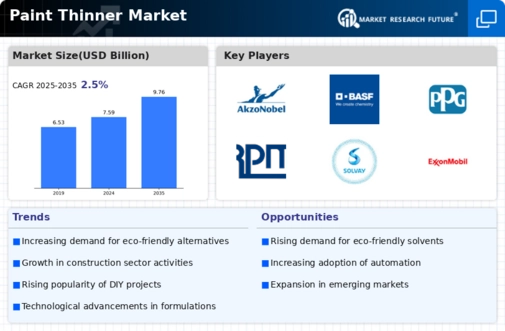Market Growth Projections
Growth in Automotive Industry
The automotive sector significantly influences the Global Paint Thinner Market Industry, as manufacturers utilize paint thinners for vehicle finishing processes. The increasing production of automobiles, particularly in emerging markets, drives the demand for high-quality coatings and thinners. With advancements in automotive technology and design, the need for specialized paint thinners that enhance durability and aesthetics becomes paramount. This sector's growth contributes to the overall market expansion, with projections indicating a compound annual growth rate of 2.31% from 2025 to 2035, underscoring the automotive industry's role in shaping paint thinner consumption.
Rising Demand in Construction Sector
The Global Paint Thinner Market Industry experiences a surge in demand driven by the construction sector's expansion. As urbanization accelerates, the need for residential and commercial buildings increases, leading to higher consumption of paints and coatings. Paint thinners are essential for achieving desired finishes and maintaining equipment. In 2024, the market is projected to reach 7.59 USD Billion, reflecting the industry's growth trajectory. This trend is expected to continue, with the market anticipated to reach 9.76 USD Billion by 2035, indicating a robust demand for paint thinners as construction activities intensify globally.
Technological Advancements in Production
Technological advancements in the production of paint thinners are reshaping the Global Paint Thinner Market Industry. Innovations in chemical formulations and manufacturing processes enhance the efficiency and effectiveness of thinners, leading to improved product quality. These advancements allow for the development of specialized thinners that cater to diverse applications, from industrial to artistic uses. As manufacturers adopt cutting-edge technologies, the market is likely to benefit from increased production capabilities and reduced costs. This evolution not only meets the rising demand but also positions the industry for sustainable growth in the coming years.
Environmental Regulations and Innovations
The Global Paint Thinner Market Industry is increasingly influenced by stringent environmental regulations aimed at reducing volatile organic compounds (VOCs) in paint products. As governments worldwide enforce these regulations, manufacturers are compelled to innovate and develop eco-friendly paint thinners. This shift towards sustainable products not only aligns with regulatory requirements but also caters to the growing consumer preference for environmentally responsible solutions. Consequently, the market is witnessing a transformation, with an emphasis on low-VOC and water-based thinners, which are gaining traction among consumers and businesses alike, thereby reshaping industry dynamics.
Consumer Preferences for High-Quality Finishes
The Global Paint Thinner Market Industry is significantly impacted by changing consumer preferences towards high-quality finishes in various applications. As consumers become more discerning, the demand for superior paint products that require effective thinners increases. This trend is evident across sectors such as home improvement, automotive, and industrial applications, where the quality of the final product is paramount. Consequently, manufacturers are focusing on producing premium thinners that enhance the performance of paints, thereby driving market growth. The emphasis on quality is likely to sustain the industry's expansion as consumers prioritize aesthetics and durability.






















